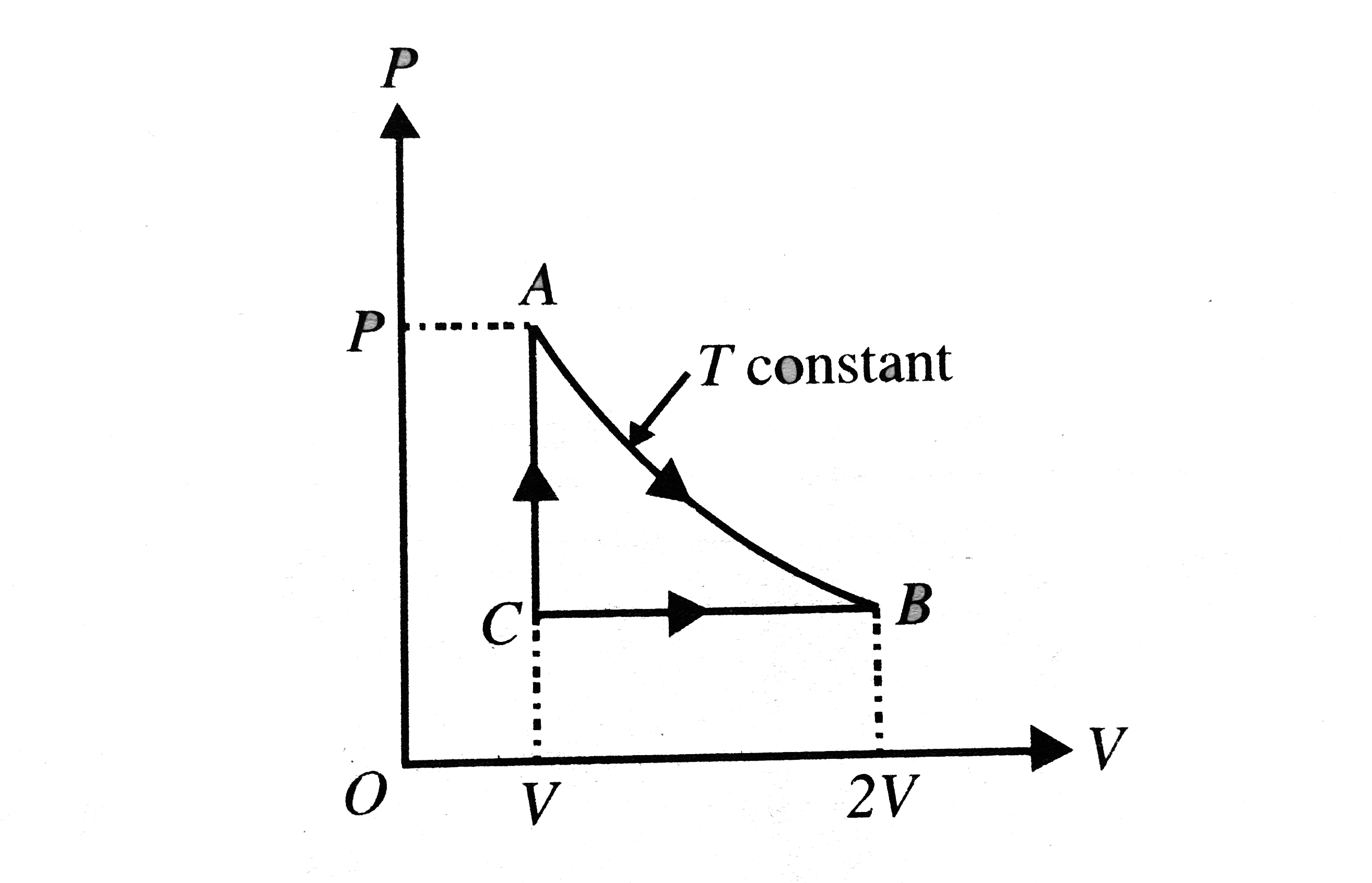A gas is initially at a pressure of 100kPa and its volume is 2.0m3. Its pressure is kept constant and the volume is changed from 2.0m3 to 2.5m3. Its volume is now kept constant and the pressure is increased from 100kPa to 200kPa. The gas is brought back to its initial state, the pressure varying linearly with its volume.
(a) Whether the heat is supplied to or exerted from the gas in the complete cycle ?
(b) How much heat was supplied or extracted ?
The correct Answer is:(a) extracted (b) 2500J
To solve the problem step by step, we will analyze the processes involved and calculate the heat exchanged during the complete cycle.
Step 1: Identify the Processes
1. The gas starts at an initial state with:
- Pressure P1=100kPa=100×103Pa
- Volume V1=2.0m3
2. The first process is isobaric (constant pressure) where the volume changes from V1=2.0m3 to V2=2.5m3.
3. The second process is isochoric (constant volume) where the pressure increases from P2=100kPa to P3=200kPa at V2=2.5m3.
4. Finally, the gas returns to its initial state, which involves a linear change in pressure and volume.
Step 2: Draw the P-V Diagram
- On the P-V diagram, plot the points:
- Point 1: (V1,P1)=(2.0,100)
- Point 2: (V2,P1)=(2.5,100)
- Point 3: (V2,P3)=(2.5,200)
- Point 4: Back to (V1,P1)=(2.0,100)
Step 3: Calculate Work Done in the Cycle
- The work done during the isobaric process (1 to 2) can be calculated using:
W12=PΔV=P1(V2−V1)=100×103×(2.5−2.0)=100×103×0.5=50,000J
- The work done during the isochoric process (2 to 3) is zero since volume does not change.
- The work done during the process from point 3 back to point 1 (3 to 4) can be calculated using the area of the triangle formed in the P-V diagram:
W34=−12×Base×Height=−12×(V2−V1)×(P3−P1)
=−12×(2.5−2.0)×(200−100)×103=−12×0.5×100×103=−25,000J
- Total work done in the cycle:
Wcycle=W12+W34=50,000−25,000=25,000J
Step 4: Apply the First Law of Thermodynamics
- According to the first law of thermodynamics:
ΔU=Q−W
For a complete cycle, ΔU=0, thus:
Q=W
Since we calculated Wcycle=25,000J, the heat exchanged is:
Q=25,000J
Step 5: Determine if Heat is Supplied or Extracted
- Since the work done is positive, it indicates that heat is supplied to the gas during the cycle.
Final Answers
(a) Heat is supplied to the gas in the complete cycle.
(b) The amount of heat supplied is 25,000J.
1. The gas starts at an initial state with:
- Pressure P1=100kPa=100×103Pa
- Volume V1=2.0m3
- On the P-V diagram, plot the points:
- Point 1: (V1,P1)=(2.0,100)
- Point 2: (V2,P1)=(2.5,100)
- Point 3: (V2,P3)=(2.5,200)
- Point 4: Back to (V1,P1)=(2.0,100)
- The work done during the isobaric process (1 to 2) can be calculated using:
W12=PΔV=P1(V2−V1)=100×103×(2.5−2.0)=100×103×0.5=50,000J
W34=−12×Base×Height=−12×(V2−V1)×(P3−P1)
=−12×(2.5−2.0)×(200−100)×103=−12×0.5×100×103=−25,000J
Wcycle=W12+W34=50,000−25,000=25,000J
- According to the first law of thermodynamics:
ΔU=Q−W
For a complete cycle, ΔU=0, thus:
Q=W
Since we calculated Wcycle=25,000J, the heat exchanged is:
Q=25,000J
- Since the work done is positive, it indicates that heat is supplied to the gas during the cycle.
(a) Heat is supplied to the gas in the complete cycle.
Topper's Solved these Questions
- KTG & THERMODYNAMICSBOOK - RESONANCE ENGLISHCHAPTER - KTG & THERMODYNAMICSEXERCISE - Exercise-2
1 Videos
- KTG & THERMODYNAMICSBOOK - RESONANCE ENGLISHCHAPTER - KTG & THERMODYNAMICSEXERCISE - PART -I
15 Videos
- KTG & THERMODYNAMICSBOOK - RESONANCE ENGLISHCHAPTER - KTG & THERMODYNAMICSEXERCISE - PART -II
17 Videos
- KINETIC THEORY OF GASES AND THERMODYNAMICSBOOK - RESONANCE ENGLISHCHAPTER - KINETIC THEORY OF GASES AND THERMODYNAMICSEXERCISE - Exercise
64 Videos
- MAGNETIC FIELD AND FORCESBOOK - RESONANCE ENGLISHCHAPTER - MAGNETIC FIELD AND FORCESEXERCISE - Exercise
64 Videos
Similar Questions
At what temperature will 500cm3 of a gas measured at 20∘C occupy half its volume ? The pressure is kept constant.
View Solutionthe pressure of a gas change linearly with volume from 10kPa, 200 cc to 50 kPa, 50 cc. (a) calculate the work done by the gas, (b) If no heat is supplied or extracted from the gas, what is the change in the internal energy of the gas ?
View SolutionIf 10g of a gas at 1 atmospheric pressure is cooled from 273∘C to 0∘C, keeping the volume constant, its pressure would become
View SolutionThe pressure of the gas in a constant volume gas thermometer is 70 kPa at the ice point. Find the pressure at the steam point.
View SolutionOne mole of a gas is carried through the cycle shown in Fig. The gas expands at constant temperature T from volume V to 2V. It is them compressed to the initial volume at constant pressure and is finally brought back to its original state by heating at constant volume. Calculate the work done by the gas in complete cycle.

View SolutionAn ideal gas initially at pressure 1 bar is being compressed from 30m3 to 10m3 volume and its temperature decreases from 320 K to 280 K then find final pressure of gas.
View SolutionThe pressure of a gas kept in an isothermal container is 200Kpa. If half the gas is removed from it, the pressure will be
View SolutionA perfect gas at 27∘C is heated at constant pressure so as to triple its volume. The tmemperature of th gas will be
View SolutionA perfect gas at 27∘C is heated at constant pressure so as to triple its volume. The tmemperature of th gas will be
View SolutionThe temperature of a gas is raised while its volume remains constant, the pressure exerted by the gas on the walls of the container increases because its molecules
View Solution
